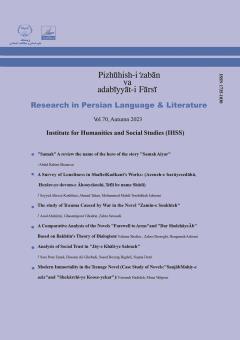Examining the meaning of imperative propositions is one of the topics related to rhetoric (semantics). As a result of this study, it is possible to follow the orientation of poets' thoughts and interests on various topics; Because usually the initial interpretation of
More
Examining the meaning of imperative propositions is one of the topics related to rhetoric (semantics). As a result of this study, it is possible to follow the orientation of poets' thoughts and interests on various topics; Because usually the initial interpretation of imperative propositions is imperative and order, while poets consider different meanings and intentions of imperative propositions, and this issue is more important in Hafez's poems due to the analytical-inferential structure of imperative sentences; A topic that unfortunately has not been well explored. Therefore, in this article, Hafez's imperative propositions in the first 250 lyric poems of Hafez's Divan have been studied by content analysis method (descriptive-analytical approach) and finally it has been determined that in the first 250 lyric poems of Hafez Divan (equivalent to 2098 bits), in 724 verses,there are imperative sentences (554 beits have a positive imperative and 170 beits have a negative imperative) and Hafez is a great imperativeer from this point of view.Of these, the frequency of imperative sentences with the meanings of desire and guidance is high, and perhaps this is one of the reasons for Fortune telling with Divan Hafez.In more than 35% of these poems, the construction of compound imperative sentence-analytic / inferential sentences is used, in such a way that the reader, after reading those imperative sentences, is mentally convinced and forgets the bitterness of the advice. In this article, Hafez's imperative sentences are also examined based on the type of speaker, audience and demand, and in all cases, an attempt is made to find a connection between Hafez's personal style and its results.
Manuscript profile


